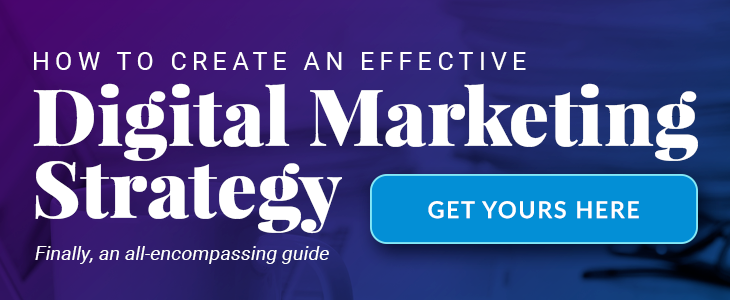
What is Digital Marketing? Your Checklist of 15 Essential Elements

Marketing experts debate the beginning of digital marketing. But the term first appeared in the 1990s as online advertising, search and technology began their growth trajectory. The early days were dotted with a wide variety of firsts as the pioneers explored the new online world—like the first search engine called Archie (short for “archive”) in 1990.
Then there was the first clickable web ad sold by Global Network Navigator (GNN) to a law firm in 1993; the first online sales transaction when the singer Sting’s friends purchased his CD in 1994; the first internet marketing agency designing websites and interactive media (on CD-ROMs) for early adopters, and building “electronic malls” for clients throughout the 1990s; and the first mobile marketing campaign in North America by Labatt Breweries in 2002.
Digital marketing has come a long way from its humble origins—and it may leave many professionals wondering, “What is digital marketing in 2018?” Today, experts define it in various ways. But basically digital marketing is the promotion of products or brands via one or more digital channels, including search engines, websites, social media and email. Executing digital marketing successfully requires doing a number of things right. The list of key variables is nearly endless. However, these 15 elements are essential components of digital marketing today.
What is Digital Marketing? 15 Elements Necessary Today
Element 1—Digital Marketing Strategy
Driving revenue is likely the ultimate goal of your digital marketing program. But it’s the “how” you need to identify with laser clarity. As such, a successful digital marketing strategy begins with setting goals. Ideally, your marketing goals should align with your business goals. For example, are you aiming to drive brand awareness, shorten the sales cycle or increase customer satisfaction? A great way to measure your impact is by establishing Key Performance Indicators (KPIs), of which there are literally hundreds. A few tried-and-true examples are: website visits, lead conversions, social media engagement and sales qualified leads. KPIs help you plan your campaigns and tactics with greater insight when they are based on a combination of your historical marketing performance and the goals of your new campaigns.
Element 2—Value-based Messaging
What is the core message your company or brand needs to communicate to your leads, prospects and customers? This will be the beating heart of your digital marketing program. Before you create any content, you should be clear on your company’s value messaging, because it will be the foundation on which you build your digital marketing plan. Your digital marketing content should speak to the needs of potential buyers and introduce them to the value of your product or service. To be heard in our congested space, your message needs to retain a consistent voice and tone. This will support your success by building a following, inspiring consumer loyalty and strengthening connections with customers.
Element 3—Marketing Automation
Successful digital marketing is impossible to execute in 2018 without marketing automation. These systems allow you to manage a high volume of content, run multiple campaigns, create landing pages, design email campaigns, track website visitors, interact with sales teams and much more. Marketing automation systems deliver several essential benefits, including allowing marketers to customize their campaigns based on various target audiences, sales cycles, promotions and strategic planning updates.
Element 4—Buyer Personas
Before you begin creating digital marketing campaigns, first you need to create your buyer personas. These will intelligently guide your content strategy—from what type of content you create, to what you say, to how you promote it. Every audience is different, so you need to know what fears keep them up at night, what they are held accountable for, what factors motivate them and what media they consume. The more details you know, the more narrowly you can focus your campaigns and the better results you’ll get.
Element 5—Websites
Your website is a vital piece of your digital marketing program. If it’s designed for maximum impact, it will make your marketing more effective. In today’s online world, your website must be responsive to any device, publish relevant and up-to-date content, clearly communicate your company’s values, include product-specific landing pages for PPC efforts and integrate with customer relationship management and marketing automation tools.
Element 6—Content Marketing
So much of your digital marketing plan will center around high-quality content, including blog posts, case studies, eBooks, infographics and more. Consider your content as the fuel that makes the magic happen. Delivering the right content to the right place at the right time is crucial to any digital success. Today’s consumers are empowered to seek out high-quality digital resources and experiences that lead to better, more informed decision-making. Unless a company is producing a wide variety of interesting original content, there’s no reason for people to visit its website or social media sites or read its emails. When creating content remember this axiom: Today’s buyers want companies to help facilitate the buying process by providing the information needed to make a wise decision.
Element 7—Email Marketing
Today, email marketing is king because it is one of the most effective ways to communicate with targeted audiences. Whether your goal is to generate leads, convert prospects, develop relationships with your customers or achieve any other objective, email marketing is the most effective way to succeed. A solid digital marketing program requires a strong email strategy that achieves several important goals: driving traffic to your website, educating and informing prospective buyers with new content, ensuring your brand stays top-of-mind, building your credibility and establishing your company as a thought leader.
Element 8—Social Media Strategy
Social media has an important role to play in your marketing plan. Research shows that it not only works for B2C marketing, but also B2B, because a growing number of businesspeople use social media in their purchase decision process. To optimize your social media strategy, you need to determine which platforms will work best for your business. There is no “one size fits all” with social media.
Element 9—Online Ads
You can’t expect customers to flock to your website as soon as your product is released. Organic search is valuable, but paid advertisements, such as Google Adwords and display ads, are also a powerful way to gain exposure. Reasons to invest in paid ads include: reaching targeted consumers through the right channels, paying only when an interested individual clicks on an ad, controlling your spending budget and gaining immediate results.
Element 10—Videos
Research from multiple sources points to the power of video to influence successful digital marketing programs. Many experts predict that video will soon take the lead position in content that has the power to attract and convert consumers. By implementing video in your digital marketing strategy, you gain an effective way to present your company’s values, your products’ features and your brand message in ways that people want and expect to receive it.
Element 11—Search Engine Optimization
The higher you place in search engine rankings the better chance you have of success executing your digital marketing plan. To rank high, you have to consider the type of search terms your potential buyers would use when searching for what you offer. Once you’ve gathered a list of keyword search terms, you can strategically develop content around those terms in your blog posts, how-to guides, eBooks, infographics and website.
Element 12—Conversion Rate Optimization (CRO)
CRO is the process of getting more conversions from your existing traffic. For example, instead of getting a 1 percent conversion rate, you can make changes in certain elements of your campaigns—such as content, button size, image and placement—that boost your conversion rate by 2 or 3 percent. CRO is more cost effective than finding new visitors, minimizes the risk of attracting the wrong kinds of visitors, and delivers the opportunity to achieve a better content marketing ROI.
Element 13—Sales Enablement
Sales enablement is concerned with equipping sales reps with a steady stream of qualified leads and the tools they need to convert them into customers. Unless you’re only selling in online stores, all of your digital marketing efforts should be focused on producing leads for your sales team and enabling them to sell with the right automated solutions and content to perform their magic.
Element 14—Customer Relationship Management (CRM)
Your customers are your lifeblood. They’re everything you’ve been working to find, nurture and convert. But you also have to retain them. This means you have to manage them well. Enter Customer Relationship Management (CRM). These systems give you one central place from which to communicate with and better understand your customers. Ideally, you CRM system should empower you to perform several functions, including maintain a central list of information on your leads and customers, track all conversations with customers across your entire team and better understand the effectiveness of your sales efforts.
Element 15—Analytics
The final element of successful digital marketing is conducting analytics on your results and tweaking your process to gain improvements in meeting your revenue goals and KPIs. In fact, one of the most valuable elements of having a digital marketing strategy is that you can continually monitor the outcomes and optimize your strategy. There are several analytics tools that can assist you in tracking your marketing progress. With the right information in hand, you’ll be able to plan and execute your strategies with precision—and maximize your ROI.
Stop asking, “What is digital marketing?” and start investing. Having a solid plan in place can help you meet customers where they are online and maximize your marketing budget. To help you get started on the right foot, check out our new guide—How to Create a Digital Marketing Strategy—and learn what you should know to create a successful digital marketing plan this year.





